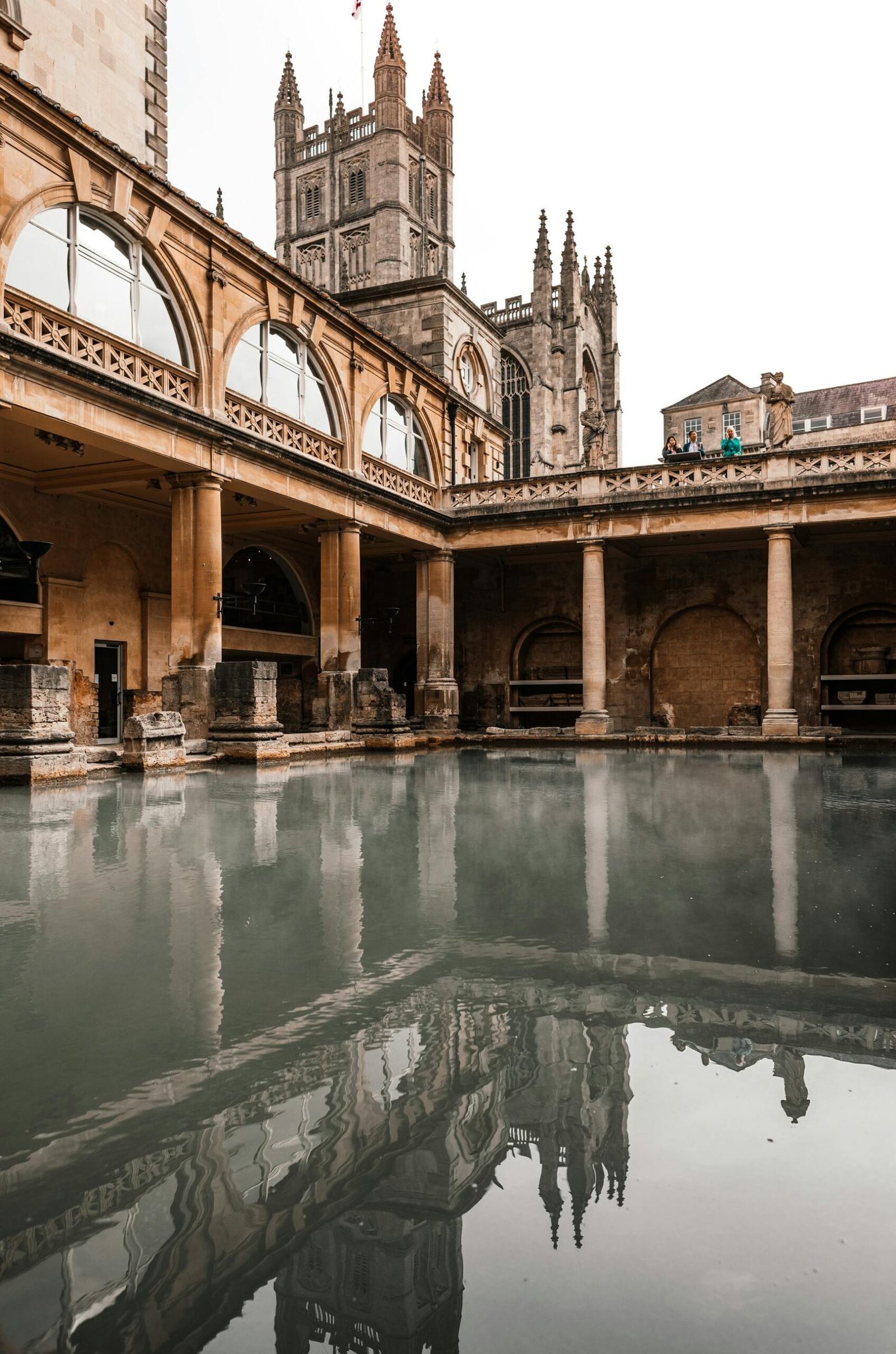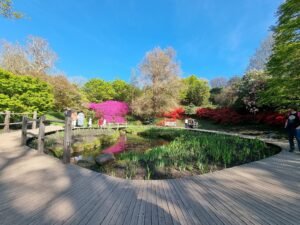
Table of Contents
Introduction: Exploring the Timeless Charm of Bath

Welcome to Bath, a city steeped in history, elegance, and romance. Nestled in the picturesque countryside of England, it beckons visitors with its iconic landmarks, centuries-old architecture, and tranquil ambiance. As we embark on a virtual journey through this enchanting city, we invite you to join us in discovering its rich heritage, architectural treasures, and romantic allure.
From the ancient Roman baths to the majestic Georgian crescents, the countryside offers a tapestry of experiences that transport visitors back in time to eras of opulence, sophistication, and cultural significance. Whether you’re drawn to its historic sites, its natural hot springs, or its charming streets lined with boutique shops and cafes, the city has something to enchant and delight every traveler.
Join us as we wander through the cobblestone streets, explore hidden alleyways, and immerse ourselves in the timeless beauty of Bath—a city where the past meets the present in a seamless blend of history, culture, and romance. So, grab your virtual passport and let’s begin our journey into the heart of Bath’s city, where every corner reveals a story waiting to be told and memories waiting to be made.
Roman Bath House: Delving into the Depths of Ancient Civilization

Step back in time and immerse yourself in the captivating world of ancient Rome as we embark on a journey to explore the legendary Roman Bath House. This iconic archaeological site offers a unique glimpse into the daily lives, customs, and rituals of our ancient ancestors, providing invaluable insights into the rich tapestry of Roman civilization.
A Hub of Social Activity:

In its heyday, it served as far more than a mere bathing facility—it was a bustling hub of social activity, commerce, and relaxation. Here, citizens of all walks of life would gather to bathe, socialize, and seek respite from the hustle and bustle of daily life. The baths were not only a place to cleanse the body but also to rejuvenate the mind and spirit, fostering a sense of community and camaraderie among the people of ancient time.
Thermal Springs:

At the heart of the Roman Bath House lies its most remarkable feature—the natural thermal springs that have been flowing for thousands of years. Believed to possess healing properties, these mineral-rich waters were revered by the ancient Romans for their ability to soothe ailments and promote well-being. Visitors to the bath house would indulge in luxurious baths, massages, and spa treatments, immersing themselves in the restorative powers of the thermal waters.
Architectural Splendor:

As we wander through the ruins of the place, we are struck by the architectural splendor that surrounds us. From the grandeur of the Great Bath, with its monumental columns and soaring vaulted ceilings, to the intricate mosaic floors and ornate carvings that adorn the walls, every corner of the bath house reflects the skill and craftsmanship of its ancient builders. It is a testament to the ingenuity and engineering prowess of the Roman civilization, showcasing their ability to create enduring architectural masterpieces that stand the test of time.
Rituals and Traditions:

We gain insight into the rituals and traditions that were integral to the bathing experience in ancient Rome. From the elaborate bathing rituals and ceremonies to the offerings made to the gods for protection and prosperity, every aspect of the bathing experience was imbued with symbolism and significance. It was a time-honored tradition that fostered a sense of connection to the divine and reinforced the social bonds that held Roman society together.
Legacy of the Baths:
Today, it stands as a tangible reminder of the enduring legacy of Roman civilization—a legacy that continues to captivate and inspire visitors from around the world. As we marvel at the ancient ruins and contemplate the mysteries of the past, we are reminded of the timeless appeal of the baths—a place where history, culture, and wellness converge in perfect harmony. It is a testament to the enduring power of the human spirit and the timeless allure of ancient civilizations.
The Royal Crescent: A Stately Symbol of Georgian Elegance

Nestled in the heart of the city, the Royal Crescent stands as a majestic testament to the architectural brilliance of the Georgian era. With its graceful curves, elegant facades, and panoramic views of the surrounding countryside, the Royal Crescent epitomizes the timeless beauty and refined elegance of Bath’s aristocratic past.
Architectural Masterpiece:

Designed by the renowned architect John Wood the Younger and completed in 1774, the Royal Crescent is a masterpiece of Georgian architecture. Its iconic crescent-shaped facade, comprising 30 terraced townhouses, is a symphony of Palladian proportions, classical motifs, and neoclassical detailing. Each residence boasts a unique blend of symmetry, proportion, and elegance, creating a harmonious streetscape that is both grand and graceful.
Panoramic Views:

One of the most striking features of the Royal Crescent is its breathtaking views of the surrounding countryside. From the vantage point of the crescent’s sweeping lawn, residents and visitors alike can enjoy uninterrupted vistas of the rolling hills, lush valleys, and meandering rivers that characterize the picturesque landscape of Bath and its environs. It is a scene of timeless beauty that has captivated artists, poets, and travelers for centuries.
Luxurious Living:
In its heyday, the Royal Crescent was the epitome of luxury and sophistication—a favored residence of Bath’s aristocratic elite and visiting dignitaries. Behind its elegant facades lay sumptuous interiors adorned with opulent furnishings, exquisite artwork, and the latest amenities of the day. From grand drawing rooms to cozy parlors, each residence offered a haven of comfort and refinement for its discerning occupants.
Cultural Icon:
Over the centuries, the Royal Crescent has become an enduring symbol of Bath’s cultural heritage and architectural legacy. Its timeless beauty and historical significance have earned it recognition as a UNESCO World Heritage Site and a must-see destination for visitors from around the world. Whether admired from afar or explored up close, the Royal Crescent continues to inspire awe and admiration, serving as a testament to the enduring allure of Georgian elegance.
A Timeless Legacy:
As we wander along the graceful curve of the Royal Crescent, we are transported back in time to an era of refinement, grace, and sophistication. It is a place where the past meets the present, where history comes alive amidst the timeless beauty of Bath’s architectural treasures. Whether basking in the glow of the afternoon sun or marveling at the crescent’s illuminated facade by night, the Royal Crescent remains a beacon of elegance and inspiration—a stately symbol of Georgian splendor that will forever captivate the hearts and imaginations of all who behold it.
Bath Abbey: A Symbol of Faith and Heritage

In the heart of the historic city, there stands a towering masterpiece of Gothic architecture—Bath Abbey. With its soaring spires, intricate carvings, and stunning stained glass windows, the abbey is not only a place of worship but also a symbol of faith, heritage, and architectural excellence.
Spiritual Sanctuary:
For centuries, the Abbey has been a place of spiritual solace and contemplation for pilgrims, worshippers, and visitors alike. Its sacred halls echo with the prayers, hymns, and rituals of generations past, offering a sanctuary of peace and tranquility amidst the hustle and bustle of modern life. Whether attending a service, lighting a candle, or simply sitting in silent reflection, visitors to the abbey are invited to connect with the divine and find solace in its sacred spaces.
Architectural Marvel:
The Abbey is renowned for its exquisite architecture, which seamlessly blends elements of Gothic, Norman, and Perpendicular styles. From the intricately carved facade to the majestic fan vaulting of the nave, every aspect of the abbey’s design reflects the skill and craftsmanship of its medieval builders. The abbey’s West Front, adorned with its famous ladder of angels and sculpted figures, is a masterpiece of medieval sculpture—a testament to the ingenuity and creativity of the artisans who crafted it.
Architectural Marvel:
One of the most striking features of Bath Abbey is its stunning collection of stained glass windows. Dating back to the 12th century, these exquisite windows depict scenes from the Bible, saints, martyrs, and other religious themes, illuminating the abbey’s interior with a kaleidoscope of vibrant colors and ethereal light. From the majestic Great East Window to the intimate Lady Chapel windows, each piece of stained glass is a work of art in its own right, inviting contemplation and awe from all who behold it.
Cultural Heritage:
The church is not only a place of worship but also a living testament to the rich cultural heritage of the city. Its history is intertwined with that of the city itself, from its origins as a medieval monastery to its role as a center of religious and civic life. Today, it continues to serve as a focal point for community gatherings, concerts, and cultural events, preserving and celebrating the traditions of the past while embracing the spirit of innovation and inclusivity.
Legacy of Faith:
In addition to its architectural splendor and natural beauty, the city holds a significant place in literary history as the city where renowned author Jane Austen spent a portion of her life. During the early 19th century, the city was a vibrant social hub frequented by the British aristocracy, and it served as the backdrop for two of Austen’s most beloved novels, “Northanger Abbey” and “Persuasion.”
Jane Austen’s Stay:

n 1801, following the death of her father, Jane Austen moved to Bath with her mother and sister, Cassandra. The family settled in a series of rented accommodations around the city, including Sydney Place and Green Park Buildings, seeking a change of scenery and hoping to find suitable matches for Jane and Cassandra in Bath’s bustling social scene.
Influence on Austen’s Writing:

Jane Austen’s time in the city had a profound influence on her writing, as evidenced by the vivid descriptions of the place and its society in her novels. In “Northanger Abbey,” it serves as the setting for much of the story, providing a backdrop of elegance, intrigue, and social maneuvering for the novel’s protagonist, Catherine Morland. Similarly, in “Persuasion,” it features prominently as the setting for pivotal events in the lives of the novel’s characters, including the poignant reunion of Anne Elliot and Captain Wentworth
Exploring Austen’s Place:

Today, visitors to the city can explore many of the places associated with Jane Austen’s time in the city, including the Jane Austen Centre—a museum dedicated to her life and works. The museum offers a fascinating glimpse into Regency-era Bath, featuring exhibits on Austen’s time in the city, her social circle, and the inspiration behind her novels. Visitors can also take guided walking tours of the city that highlight locations mentioned in Austen’s novels, providing insights into the author’s life and literary legacy.
Legacy of Jane Austen:
Jane Austen’s association with Bath continues to attract literary enthusiasts from around the world, who come to walk in the footsteps of the beloved author and immerse themselves in the world of Regency-era England. Her novels, with their wit, charm, and keen insight into human nature, remain timeless classics that continue to captivate readers of all ages, ensuring that her legacy endures for generations to come.
A City of Literary Inspiration:
As we wander through the elegant streets and historical landmarks, we can’t help but feel the presence of Jane Austen, whose words and characters have left an indelible mark on the city’s cultural heritage. The city, with its timeless beauty and romantic allure, serves as a fitting backdrop for Austen’s tales of love, society, and human foibles, reminding us of the enduring power of literature to transport us to different times and places, and to touch our hearts with its universal truths.
Pulteney Bridge: Where Architecture Embraces Romance
Nestled gracefully over the tranquil waters of the River Avon, Pulteney Bridge stands as a testament to the timeless allure of architectural elegance and romantic charm. Located in the heart of the city, this iconic bridge captivates the hearts of visitors and locals alike, offering a picturesque setting where architecture and romance intertwine in perfect harmony.
Architectural Splendor:
Designed by Robert Adam and completed in 1774, Pulteney Bridge is a masterpiece of Georgian architecture, boasting graceful arches, elegant balustrades, and classical detailing that harken back to a bygone era of sophistication and refinement. Its symmetrical design and harmonious proportions create a sense of balance and symmetry that is both pleasing to the eye and evocative of the architectural ideals of the Georgian period.
Romantic Ambiance:
As the gentle waters of the River Avon flow beneath its arches, Pulteney Bridge exudes a sense of romance and tranquility that is unmatched by any other landmark in Bath. Whether admired from afar or explored up close, the bridge’s timeless beauty and scenic surroundings make it a popular spot for couples seeking a romantic rendezvous or a leisurely stroll hand in hand. As the sun sets and the soft glow of twilight envelops the bridge, it becomes a place of quiet intimacy and shared moments—a place where love blooms and memories are made.
Charming Shops and Cafes:
Lining the bridge’s historic thoroughfare are a charming array of shops, cafes, and boutiques that beckon visitors to linger and explore. From quaint tea rooms and artisanal bakeries to boutique galleries and specialty shops, Pulteney Bridge offers a delightful mix of old-world charm and modern convenience, making it the perfect destination for shopping, dining, and leisurely browsing. Whether you’re searching for a unique souvenir, savoring a cup of tea, or simply soaking in the ambiance, the bridge’s vibrant atmosphere and bustling energy are sure to enchant and delight.
Scenic Views:
From the vantage point of Pulteney Bridge, visitors are treated to panoramic views of some of Bath’s most iconic landmarks, including the majestic Bath Abbey and the historic buildings that line the riverbanks. Whether admired by day or illuminated by night, these scenic vistas provide a stunning backdrop for photos, sketches, and moments of contemplation, capturing the timeless beauty and romantic allure of Bath’s architectural treasures.
In conclusion, Pulteney Bridge is more than just a crossing over the River Avon—it is a symbol of romance, beauty, and timeless elegance that continues to captivate and inspire all who behold it. Whether admired for its architectural splendor, its scenic surroundings, or its romantic ambiance, the bridge serves as a reminder of the enduring power of love and the enduring allure of Bath’s architectural treasures.
Conclusion: Embracing the Magic

As our virtual journey through Bath draws to a close, we are left with a profound sense of wonder and appreciation for this extraordinary city. Bath’s timeless charm, rich history, and romantic ambiance have captured our hearts and imaginations, leaving an indelible mark on our memories.
From the ancient Roman baths to the elegant Georgian crescents, Bath’s architectural treasures stand as testaments to the ingenuity and creativity of generations past. Each cobblestone street, each historic landmark, tells a story of resilience, innovation, and cultural significance, inviting us to explore, learn, and discover.
But the city is more than just a collection of historic sites and architectural wonders—it is a place where the past comes alive, where the present is infused with the spirit of bygone eras, and where every moment is filled with possibility and enchantment. Whether strolling along the tranquil waters of the River Avon, admiring the panoramic views from atop the Royal Crescent, or indulging in a relaxing soak in the city’s natural hot springs, it offers a wealth of experiences that captivate the senses and nourish the soul.
As we bid farewell to this enchanting city, we carry with us the memories of our journey—the sights, the sounds, the scents—that will stay with us long after we’ve returned home. And though our time in this magnificent place may have come to an end, the magic of this extraordinary city will continue to inspire and delight us, beckoning us to return again and again to discover its secrets and revel in its timeless beauty. Until we meet again, Bath, may your streets be filled with laughter, your skies with sunshine, and your heart with the warmth of hospitality and charm that make you truly unforgettable.





Pingback: "Discovering the Majesty of Osborne House : Regal Retreat" 2024 - JourneyJournals